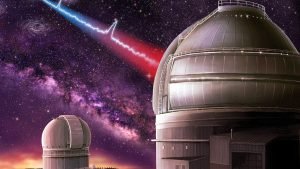Signals from deep space could be alien messages, study claims

 Scientists are always looking for signs of intelligent life beyond Earth. A new study published in The Astronomical Journal proposes a novel way of searching for such signals: listening for radio pulses from the center of the Milky Way.
Scientists are always looking for signs of intelligent life beyond Earth. A new study published in The Astronomical Journal proposes a novel way of searching for such signals: listening for radio pulses from the center of the Milky Way.
Radio pulses are short bursts of electromagnetic radiation that can be naturally produced by stars called pulsars.
However, they can also be used intentionally by humans and other civilizations to communicate across long distances. For example, radar technology uses radio pulses to detect objects and measure their speed and distance.
The researchers, led by Cornell University graduate student Akshay Suresh, developed a software that can detect these pulses and distinguish them from the background noise of space.
They tested their software on data from known pulsars and confirmed that it could pick up the narrow frequency patterns that are characteristic of artificial signals.
The researchers then applied their software to data from the Green Bank Telescope in West Virginia, which is part of the Breakthrough Listen project, a large-scale initiative to search for extraterrestrial intelligence.
They focused on the middle of the Milky Way, where there are many stars and potentially habitable planets. They also reasoned that if aliens at the core of the galaxy wanted to contact other worlds, they could use radio pulses to sweep across a large area of the sky.
“Until now, radio SETI has primarily dedicated its efforts to the search for continuous signals,” study co-author Vishal Gajjar of the SETI Institute said in a statement.
“Our study sheds light on the remarkable energy efficiency of a train of pulses as a means of interstellar communication across vast distances. Notably, this study marks the first-ever comprehensive endeavor to conduct in-depth searches for these signals.”
The researchers did not find any evidence of alien communication in their first search, but they plan to continue their efforts with more data and improved methods.
“Using narrow bandwidths and repeated patterns would be a prime way for aliens to reveal themselves, as such a combination is extremely unlikely to occur naturally,” study co-author Steve Croft, a project scientist with the Breakthrough Listen program, said in another statement.
“The method uses an algorithm that can search through 1.5 million telescope data samples in 30 minutes. Though researchers did not find any telltale signs in their first search, they say that the speed of the algorithm will help improve searches in the future.”
Greetings, explorer! We thank our supporters from the bottom of our hearts for their generous donations that keep anomalien.com alive. If you’d like to join the cause and help us continue to deliver amazing articles, please consider making a donation. Let’s keep the 👽 smiling!Follow us on Instagram, Twitter and Telegram for interesting and mysterious bonus content!




